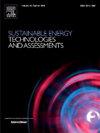The importance of conductive materials characterization and synthesis conditions in understanding DIET through biomethane production: A review
IF 7.1
2区 工程技术
Q1 ENERGY & FUELS
Sustainable Energy Technologies and Assessments
Pub Date : 2025-04-01
DOI:10.1016/j.seta.2025.104308
引用次数: 0
Abstract
Anaerobic digestion (AD) is a natural biological process by which organic materials can be broken down to produce biogas economically. The main components of biogas are CH4, CO2, and H2S, with CH4 being the most important. Several studies have discovered new materials to advance CH4 production through the reduction of CO2 and enhanced electron transfer through direct interspecies electron transfer (DIET). The current review will highlight the limited use of characterization techniques such as XPS, CHNS, and BET in the published biogas and biomethane articles in choosing suitable materials, either in biomass or biochar, based on their synthesis conditions, structure, pore size, and conductivity. Moreover, it will also include a discussion about the control of pyrdinic-N, pyrroldinic-N, and graphitic-N based on their conductivity and relation to DIET. The factors that may enhance DIET and increase methanogenesis in biochar or nanoparticles will also be discussed. The possible adverse effects of some nanoparticles and their relation to reactive oxygen species (ROS) formation, which may decrease biogas production, will also be discussed. Finally, the optimization strategy that should be adapted and employed in future biogas studies will be outlined.

导电性材料的表征和合成条件对理解生物甲烷生产的DIET的重要性综述
厌氧消化(AD)是一种自然的生物过程,通过分解有机物质,经济地产生沼气。沼气的主要成分是CH4、CO2和H2S,其中CH4最为重要。一些研究发现了新的材料,通过减少二氧化碳和通过直接种间电子转移(DIET)增强电子转移来促进CH4的产生。目前的综述将强调在已发表的沼气和生物甲烷文章中,在根据合成条件、结构、孔径和电导率选择合适的生物质或生物炭材料时,XPS、CHNS和BET等表征技术的局限性。此外,还将根据吡啶- n、吡啶- n和石墨- n的电导率及其与DIET的关系,讨论吡啶- n的控制。在生物炭或纳米颗粒中可能增强DIET和增加甲烷生成的因素也将被讨论。一些纳米颗粒可能产生的不利影响及其与活性氧(ROS)形成的关系,可能会减少沼气产量,也将被讨论。最后,概述了未来沼气研究应采用的优化策略。
本文章由计算机程序翻译,如有差异,请以英文原文为准。
求助全文
约1分钟内获得全文
求助全文
来源期刊

Sustainable Energy Technologies and Assessments
Energy-Renewable Energy, Sustainability and the Environment
CiteScore
12.70
自引率
12.50%
发文量
1091
期刊介绍:
Encouraging a transition to a sustainable energy future is imperative for our world. Technologies that enable this shift in various sectors like transportation, heating, and power systems are of utmost importance. Sustainable Energy Technologies and Assessments welcomes papers focusing on a range of aspects and levels of technological advancements in energy generation and utilization. The aim is to reduce the negative environmental impact associated with energy production and consumption, spanning from laboratory experiments to real-world applications in the commercial sector.
 求助内容:
求助内容: 应助结果提醒方式:
应助结果提醒方式:


